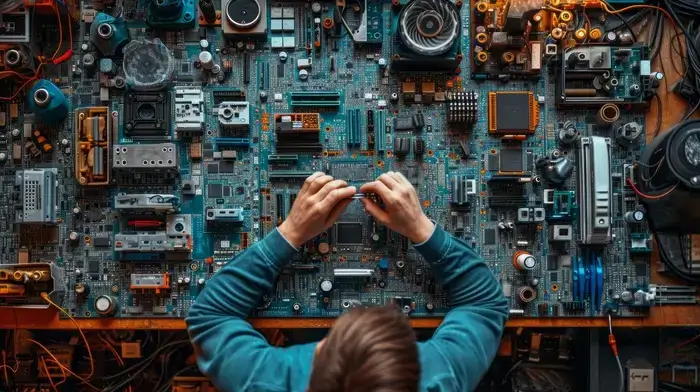What is a Memory Chip?
Agnes
- 0

What is a Memory Chip?
The memory chip stores programs and data for the microprocessor system. This information is stored in a sequence of zeros and ones called Bits. Sixteen bits make up a Word and eight Bits form a Byte.
To ensure that a particular location in the memory chip is only accessed at one time, a circuit of address decoding is used.
SRAM
The memory chip in your device determines how many games you can play, how quickly you can send an email, and how much data you can store. Different chips have different designs, manufacturing standards, and specifications, and some are better than others. Some of these are also categorized as “Read Only Memory” or “Random Access Memory.”
A common type of memory is the dynamic random-access memory (DRAM). This memory stores data temporarily and provides working memory for the computer’s central processing unit. However, it’s more expensive high voltage linear regulator than SRAM, requires a constant power supply, and can lose its data when the power is turned off.
SRAM is faster than DRAM and doesn’t require frequent refresh cycles, but it is more expensive. This makes it a popular choice for speed-sensitive caches, which are used by the CPU to speed up its operations.
Another important characteristic of a memory chip is its endurance, which refers to how long the information stored on it can be retained before it’s overwritten by new data. A higher endurance means that the information will be preserved longer, and the device will run faster. This is usually a function of the number of bits that can be written in one operation. The more bits, the more data can be stored in the memory, but the writing performance can decrease.
FLASH
Flash is non-volatile and allows data to remain stored even without power. This makes it an excellent choice for mobile devices such as cell phones and tablets. It is also used in printers and digital cameras. Flash can be programmed to perform specific functions, such as writing or reading information. It is available in several different types, including NOR and NAND flash memory chips. These chips store electrons within oxide media inside a silicon “gate.” The transistors in these chips retain electrons that a computer can interpret as 1s and 0s, and the chip links hundreds or thousands of these transistors together to work as one unit.
A primary advantage of flash is its ability to handle large quantities of structured data with high speeds and low latency. This makes it suitable for time-critical enterprise applications and structured data. However, it has lower capacity than hard drives or solid-state drives.
In addition to its storage capabilities, flash is also known for accelerating application performance. It provides 20x the speed of hard disk technology and is well-suited for common enterprise applications such as Oracle, MS-SQL, SAP, and Big Data analytics.
It is also ideal for applications requiring a fast and dependable read/write solution, such as embedded systems. In comparison to hard disks, flash has a much smaller energy footprint and is also more durable.
EEPROM
EEPROM is one of the oldest types of non-volatile memory. It consists of transistors that can store binary data by turning them on or off to represent a zero or a one. When power is switched off, the data remains there until it is erased or overwritten with new data. This makes it ideal for applications that require a long battery life.
It has a number of features that make it more attractive than other kinds of memory chips. It can be reprogrammed a certain number of times, known as the maximum life cycle. Its read and write cycles are also much faster than those of RAM. It can also be erased by sending electrical signals. It can be programmed byte by byte, which is useful for applications that need to modify the software on a computer.
The EEPROM chip can be programmed by using an EPROM programmer, which “burns” the necessary data in machine code onto the chip. It can also be reprogrammed by exposing it to UV light for several minutes. An EPROM contains a small window at the top, which must be kept covered to prevent sunlight from erasing its contents.
The EEPROM has two field effect transistors, with the storage transistor having what is called a floating gate. This gate can hold electrons, which correspond to a 0 or a 1. When a voltage is applied, the electrons can dissipate into the substrate. This causes the current to stop flowing through the gate, which can then be programmed again.
Secondary Memory
Secondary memory (also known as external storage) is a type of computer memory that is non-volatile, meaning it retains data even when the power is turned off. It also has a much larger storage capacity than primary memory, which makes it ideal for storing large amounts of data and programs.
Memory chips are small squares of silicon that contain transistors that can be switched on or off to represent a zero or a one. In the beginning, each chip held just one transistor, but as designers crisscrossed each area with more and more transistors, each chip began to hold more and more bits of information.
There are many important specifications to keep in mind when buying memory chips. These include the data rate, which measures how many bits can be read or written per second. The write endurance, which describes how long a chip can store new data before rms to dc converter it is overwritten with old data, and the read/write speed are also important factors.
Depending on the use case, the storage solution may also need to provide additional functions such as data compression and deduplication. This will require more memory and more processing power, so it is important to balance the needs of the application with the available memory capacity.

